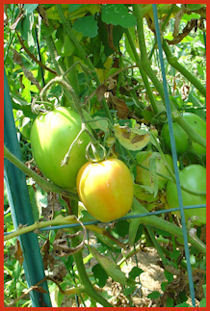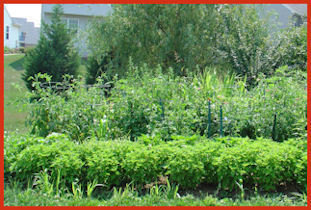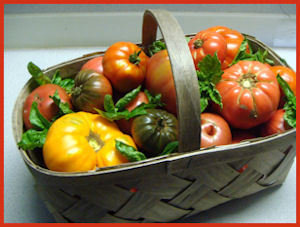





Last summer's runaway "late blight" wiped out tomato harvests for a lot of us and left us ready to panic at the first sign on disease on our plants. If you see signs of problems on your plants this summer, don't despair. Late blight isn't the only possibility, and most of the alternatives are far easier to both prevent and treat!
The first step in avoiding disease is getting healthy plants. If you save seeds, ferment them to kill pathogens. If you buy plants, look not just for healthy individual plants but also check the other plants in stock to see that their leaves aren't spotted or yellowed. Sometimes, yellow leaves just mean the plants have been over- or under-watered, but other times they're a sign of trouble.
The big issue for tomatoes last year was Late Blight, which turned plants to black mush almost overnight. But many have some trouble every year with one or another of the fungal blights that are more treatable and less fatal than Late Blight. Prevention and treatment for most of these is the same, so it's OK if you aren't sure exactly what's causing your problem. Damp foliage promotes fungal growth, so water from the bottom with soaker hoses. Good air circulation can really help, so wider spacing or a little pruning may be in order. Mulching under the plants not only suppresses weeds but also prevents hard rain from splashing soil - and fungal spores - up onto the foliage. Pruning low branches can also prevent infection from the soil surface.
If leaves start getting yellow or spotty or curled, or your plants show other signs of disease, what can you do? If just a portion of the plant is affected, you may be able to slow or stop the problem by pruning off the diseased branches and leaves. Disinfect your pruners between plants. Don't put them in your  compost pile, just throw them away. If you're using a sprinkler, switch to a bottom watering method. If you planted your tomatoes too close together, prune back some of the jungle for better air circulation. For most tomato diseases, you don't need to immediately yank out the sick plants to save the rest of your garden (as is advised for late blight).
compost pile, just throw them away. If you're using a sprinkler, switch to a bottom watering method. If you planted your tomatoes too close together, prune back some of the jungle for better air circulation. For most tomato diseases, you don't need to immediately yank out the sick plants to save the rest of your garden (as is advised for late blight).
Everybody has a different opinion on the use of chemicals, but this can be a great time to use an anti-fungal product like Daconil™, now marketed as Ortho Garden Disease Control™. It will combat any of the fungal blights. Copper sprays can also be effective against fungi and bacteria, but although they are generally considered "organic," they may actually be more toxic then some of the non-organic anti-fungal sprays. You can try other organic treatments (neem oil, milk sprays, Messsenger™, etc.), but these may not work as well, especially if the blight has a good head start. Read labels, and make your own decision.
If you spray plants preventatively or at the very first sign of disease, you may be able to control the problem without using a lot of product. Even late blight may be preventable by early and regular use of an anti-fungal treatment. This year, my tomato seedlings got spotted with early blight before they were even planted out in the garden! I sprayed them once with Ortho GDC, planted as usual, and weeks later the foliage still looks healthy. Once most of the plant is spotted and yellowing, the problem may be harder to control, although you can usually knock it back enough to harvest some tomatoes.
 How do you tell what's wrong with your tomato plants? The Tomatoes Discussion Forum is a good place to post photos, compare symptoms, and come up with solutions. For treatment, the most important determination is whether your plants have a fungus, a bacterium, or some other issue. In my area, spotted and yellowing leaves are most likely either Septoria Leaf Spot (Septoria lycopersici) or Early Blight (Alternaria solani). Other possibilities range from Bacterial Speck (Pseudomonas syringae) to Grey Mold (Bortrytis cinarea). If your plants show symptoms early in the season or if they're still alive a week or more after you started seeing problem, it's not Late Blight (Phytophthora infestans).
How do you tell what's wrong with your tomato plants? The Tomatoes Discussion Forum is a good place to post photos, compare symptoms, and come up with solutions. For treatment, the most important determination is whether your plants have a fungus, a bacterium, or some other issue. In my area, spotted and yellowing leaves are most likely either Septoria Leaf Spot (Septoria lycopersici) or Early Blight (Alternaria solani). Other possibilities range from Bacterial Speck (Pseudomonas syringae) to Grey Mold (Bortrytis cinarea). If your plants show symptoms early in the season or if they're still alive a week or more after you started seeing problem, it's not Late Blight (Phytophthora infestans).
Curling leaves could mean spider mites, herbicide drift, or just uneven watering. Most of the time, plants grow out of leaf curl issues (insecticidal soap and other sprays can kill spider mites). If your plants are being stripped of their leaves altogether, some critter is probably the culprit. Hornworms are well camouflaged, but their dark frass is easy to spot. Rabbits and groundhogs may be eating more from thirst than from hunger, so giving them a source of water can be helpful.
At the end of the season, if you've had any blight or disease problems, don't compost your tomato plants, and don't just leave them in your garden to till under later. Fungal spores and other pathogens can overwinter in your soil, and you don't want to add anything that's still on the plants to your garden. Pull them up and throw them away or burn them, depending on your local ordinances. The same applies to any plants in your garden that you're pulling up because they had disease issues. You don't want to remove the plant and keep the disease!
P lan next year's garden to reduce blight problems. Instead of planting tomatoes in patches of two or three rows, plant a longer single row to improve air circulation. Caging or staking tomatoes rather than letting them sprawl could also improve air flow as well as getting the foliage further away from soil that may harbor disease. If possible, rotate your garden crops so that tomatoes are planted in the same place no oftener than every three years.
lan next year's garden to reduce blight problems. Instead of planting tomatoes in patches of two or three rows, plant a longer single row to improve air circulation. Caging or staking tomatoes rather than letting them sprawl could also improve air flow as well as getting the foliage further away from soil that may harbor disease. If possible, rotate your garden crops so that tomatoes are planted in the same place no oftener than every three years.
With care, you can avoid the worst effects of blights in your tomato garden. The important thing is to keep an eye on your plants during the growing season. Deal promptly with anything that develops, before it has a chance to affect the entire plant or to spread throughout your garden. Tomatoes are tough. We all love our gardens to look great, but it's possible to get a respectable harvest from pretty sorry looking plants, so don't give up too soon if you run into problems.
I'm hoping the memory of last year's Late Blight trauma will be washed away by bountiful harvests from this year's tomato gardens!

Special thanks to Carolyn Male, whose expert posts on the Tomatoes forum have been invaluable to me in every step of growing my own tomatoes, from seed to harvest.
Photos by Jill M. Nicolaus. Move your mouse over images and links for additional information (let the cursor hover for a few seconds, and a popup caption will appear).
Additional information:
For more information on Bacterial Spot, Speck and Canker, see this fact sheet from the Ohio State University Extension Service.
For help in diagnosing Tomato foliage diseases, see this page from the Texas A&M Extension Service.
Have questions about Late Blight? See the excellent information published by the Cornell University Extension Service.
Copyright © www.100flowers.win Botanic Garden All Rights Reserved